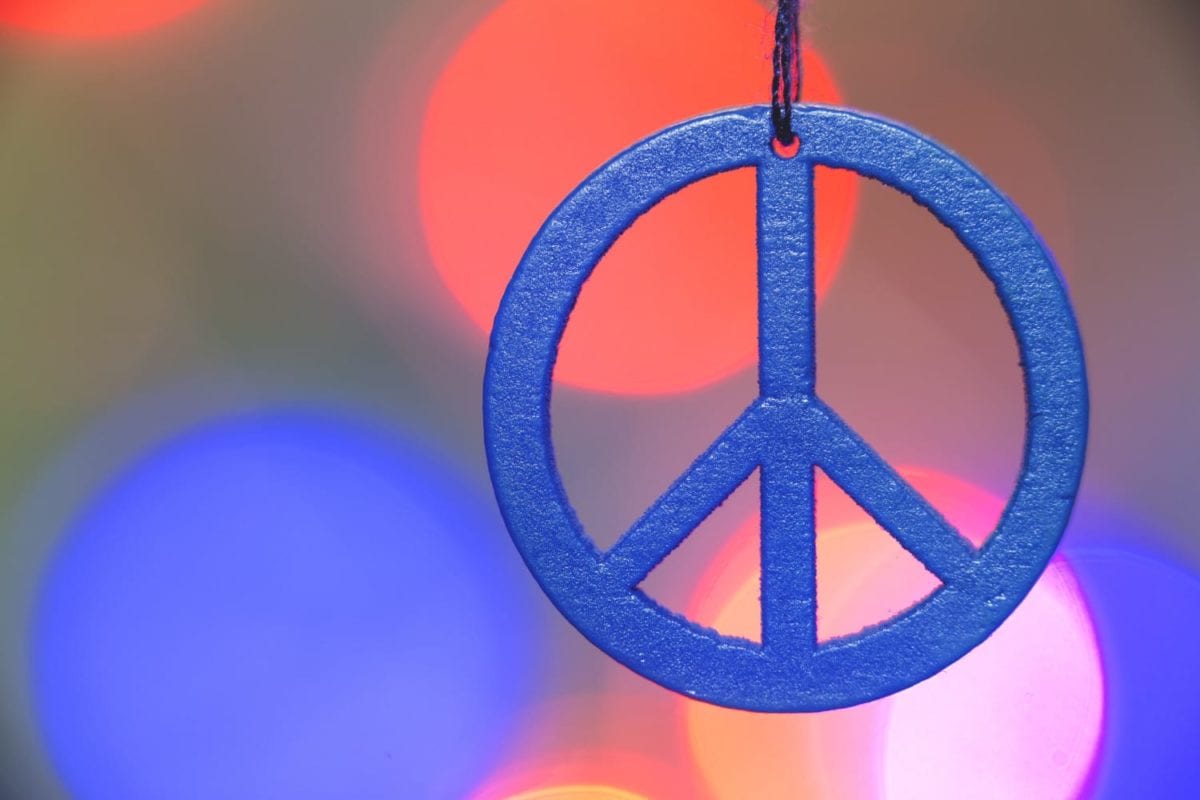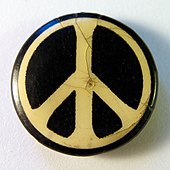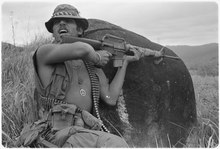The Real Origin of the Peace Symbol (and the Pentagram)

However, it is seen by many as pagan or occultic, or even anti-Christian. You’ll often find statements like the following by Cindy Jacobs in her book Deliver Us from Evil:
This came to characterize the ideal of peace in the hippie era. But occultists equate the emblem with the cross of Nero. It is meant to depict an inverted and broken Cross and to send out a call to defeat Christianity. (Appendix 3, pages 242-243)Or these:
In 1968, the anti-Communist evangelist Billy James Hargis described the symbol as a “broken cross”, which he claimed represented the antichrist. Hargis’ interpretation was taken up by a member of the John Birch Society, Marjorie Jensen, who wrote a pamphlet claiming the symbol was equivalent to “a symbol of the devil, with the cross reversed and broken” supposedly known as “the crow’s foot or witch’s foot”. In June 1970, American Opinion, the journal of the John Birch Society, published an article which compared the symbol to a supposed “broken cross” claimed to have been “carried by the Moors when they invaded Spain in the 8th century”.https://en.wikipedia.org/wiki/Peace_symbols#Interpretations
In reality these claims are, to put it politely, unsubstantiated. There is literally no evidence to support them (just as there’s little to no evidence to support Christmas’ and Easter’s supposedly “pagan” origins). They appear to be fabrications.
The history, origin and meaning of the symbol are quite well-documented – and it’s actually pretty mundane.
The symbol now known internationally as the “peace symbol” or “peace sign”, or alternatively as the nuclear disarmament symbol, or the CND symbol (Campaign for Nuclear Disarmament)[49] originates as a symbol representing the threat of nuclear annihilation used in British anti-nuclear activism from 1958. It was widely adopted in the US American anti-war movement in the 1960s and was re-interpreted as generically representing world peace. It was still used, however, in its original anti-nuclear context by activists opposing nuclear power, in the 1980s.https://en.wikipedia.org/wiki/Peace_symbols#Peace_symbol
Origin
Campaign for Nuclear Disarmament badge (1960s)A U.S. soldier in Vietnam wearing various amulets, including the “peace symbol” and the Buddhist swastika (1971 photograph).The symbol was designed by Gerald Holtom (1914–1985) for the British nuclear disarmament movement. Holtom, an artist and designer, presented it to the Direct Action Committee on 21 February 1958 where it was “immediately accepted” as a symbol for a march from Trafalgar Square, London, to the Atomic Weapons Research Establishment at Aldermaston in Berkshire on 4 April.[50][49][51][52] Holtom’s design was adapted by Eric Austen (1922–1999) to ceramic lapel badges.[53][54] The original design is in the Peace Museum in Bradford, England.[53]A “peace symbol” forming part of the “Hippie Memorial” (1992) in Arcola, Illinois, United States.
The symbol is a super-imposition of the flag semaphore for the characters “N” and “D”, taken to stand for “nuclear disarmament”.[2] This observation was made as early as 5 April 1958 in the Manchester Guardian.[55][56] In addition to this primary genesis, Holtom additionally cited as inspiration Goya’s Peasant Before the Firing Squad:
I was in despair. Deep despair. I drew myself: the representative of an individual in despair, with hands palm outstretched outwards and downwards in the manner of Goya’s peasant before the firing squad. I formalised the drawing into a line and put a circle round it.[57]The reference is to Goya‘s The Third of May 1808 (1814), although the peasant shown in this painting has his arms stretched upwards, not downwards.
Ken Kolsbun, a correspondent of Holtom’s, says that the designer came to regret the symbolism of despair, as he felt that peace was something to be celebrated and wanted the symbol to be inverted.[58] Eric Austen is said to have “discovered that the ‘gesture of despair’ motif had long been associated with ‘the death of man’, and the circle with ‘the unborn child'”.[53]
The symbol became the badge of CND, and wearing it became a sign of support for the campaign urging British unilateral nuclear disarmament. An account of CND’s early history described the image as “a visual adhesive to bind the [Aldermaston] March and later the whole Campaign together … probably the most powerful, memorable and adaptable image ever designed for a secular cause”.[53]
International reception
Not copyrighted, trademarked or restricted, the symbol spread beyond CND and was adopted by the wider disarmament and anti-war movements. It became widely known in the United States in 1958 when Albert Bigelow, a pacifist protester, sailed a small boat fitted with the CND banner into the vicinity of a nuclear test.[59] Buttons with the symbol were imported into the United States in 1960 by Philip Altbach, a freshman at the University of Chicago. Altbach had traveled to England to meet with British peace groups as a delegate from the Student Peace Union (SPU) and, on his return, he persuaded the SPU to adopt the symbol.Nuclear disarmament activist in Wellington handing out peace cranes and holding a peace symbol commemorating the atomic bombings of Hiroshima and Nagasaki (6 August 2014)).
Between 1960 and 1964, they sold thousands of the buttons on college campuses. By 1968, the symbol had been adopted as a generic peace sign,[60] associated especially with the hippie movement and opposition to the Vietnam War.[61]
In 1970, two US private companies tried to register the peace symbol as a trade mark: the Intercontinental Shoe Corporation of New York and Luv, Inc. of Miami. Commissioner of Patents William E. Schuyler Jr, said that the symbol “could not properly function as a trade mark subject to registration by the Patent Office”.[62]
In 1973, the South African government tried to ban its use by opponents of apartheid.[63]
In fact, far from being anti-Christian, Holtrom wanted to make the Cross the symbol for the anti-nuclear movement, but was advised by several priests not to make the Cross a secular protest symbol.
It also bears a resemblance to the Nordic “death rune”, which is fitting, considering its anti-nuclear origins (and its symbolising the threat of nuclear war).
What about the Pentagram?


However, they literally appropriated it from the Christians (who may have adopted it from the Greeks).
About 5 centuries ago, an occultist by the name of Heinrich Cornelius Agrippa began appropriating the symbol of Christ as a magic symbol. In the last century or two, satanists got their hands on it.Early history
In early (Ur I) monumental Sumerian script, or cuneiform, a pentagram glyph served as a logogram for the word ub, meaning “corner, angle, nook; a small room, cavity, hole; pitfall” (this later gave rise to the cuneiform sign UB 𒌒, composed of five wedges, further reduced to four in Assyrian cuneiform).[citation needed]
The word Pentemychos (πεντέμυχος lit. “five corners” or “five recesses”)[7] was the title of the cosmogony of Pherecydes of Syros.[8] Here, the “five corners” are where the seeds of Chronos are placed within the Earth in order for the cosmos to appear.[9][clarification needed]
In Neoplatonism, the pentagram was said to have been used as a symbol or sign of recognition by the Pythagoreans, who called the pentagram ὑγιεία hugieia “health”[11]A Pythagorean “Hugieia Pentagram”[10]
Western symbolism
The pentagram was used in ancient times as a Christian symbol for the five senses,[12] or of the five wounds of Christ. The pentagram plays an important symbolic role in the 14th-century English poem Sir Gawain and the Green Knight, in which the symbol decorates the shield of the hero, Gawain. The unnamed poet credits the symbol’s origin to King Solomon, and explains that each of the five interconnected points represents a virtue tied to a group of five: Gawain is perfect in his five senses and five fingers, faithful to the Five Wounds of Christ, takes courage from the five joys that Mary had of Jesus, and exemplifies the five virtues of knighthood.[13]
Thus, a Christian symbol became the epitome of evil.
http://www.cepher.net/?af=59







Comments
Post a Comment